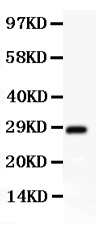Anti-SCP3 Antibody
- SPECIFICATION
- CITATIONS
- PROTOCOLS
- BACKGROUND

Application
| WB |
|---|---|
| Primary Accession | Q8IZU3 |
| Host | Rabbit |
| Reactivity | Human |
| Clonality | Polyclonal |
| Format | Lyophilized |
| Description | Rabbit IgG polyclonal antibody for Synaptonemal complex protein 3(SYCP3) detection. Tested with WB in Human. |
| Reconstitution | Add 0.2ml of distilled water will yield a concentration of 500ug/ml. |
| Gene ID | 50511 |
|---|---|
| Other Names | Synaptonemal complex protein 3, SCP-3, SYCP3, SCP3 |
| Calculated MW | 27729 MW KDa |
| Application Details | Western blot, 0.1-0.5 µg/ml, Human |
| Subcellular Localization | Nucleus . Chromosome . In tripartite segments of synaptonemal complexes, irrespective of whether these are synapsed or unsynapsed. . |
| Tissue Specificity | Testis-specific. . |
| Protein Name | Synaptonemal complex protein 3 |
| Contents | Each vial contains 5mg BSA, 0.9mg NaCl, 0.2mg Na2HPO4, 0.05mg NaN3. |
| Immunogen | E.coli-derived human SCP3 recombinant protein (Position: E18-E223). Human SCP3 shares 72% and 73% amino acid (aa) sequences identity with mouse and rat SCP3, respectively. |
| Purification | Immunogen affinity purified. |
| Cross Reactivity | No cross reactivity with other proteins |
| Storage | At -20˚C for one year. After r˚Constitution, at 4˚C for one month. It˚Can also be aliquotted and stored frozen at -20˚C for a longer time.Avoid repeated freezing and thawing. |
| Name | SYCP3 |
|---|---|
| Synonyms | SCP3 |
| Function | Component of the synaptonemal complexes (SCS), formed between homologous chromosomes during meiotic prophase. Required for centromere pairing during meiosis in male germ cells (By similarity). Required for normal meiosis during spermatogenesis and male fertility (PubMed:14643120). Plays a lesser role in female fertility. Required for efficient phosphorylation of HORMAD1 and HORMAD2 (By similarity). |
| Cellular Location | Nucleus {ECO:0000250|UniProtKB:Q60547}. Chromosome {ECO:0000250|UniProtKB:Q60547}. Chromosome, centromere {ECO:0000250|UniProtKB:Q60547}. Note=It is present in early unpaired cores, in the lateral domains of the synaptonemal complex and in the chromosome cores when they separate at diplotene. It is found axial to the metaphase I chromosomes and in association with pairs of sister centromeres. The centromere-associated protein becomes dissociated from the centromeres at anaphase II and is not found in mitotic metaphase centromeres. {ECO:0000250|UniProtKB:Q60547} |
| Tissue Location | Testis-specific. |

Thousands of laboratories across the world have published research that depended on the performance of antibodies from Abcepta to advance their research. Check out links to articles that cite our products in major peer-reviewed journals, organized by research category.
info@abcepta.com, and receive a free "I Love Antibodies" mug.
Provided below are standard protocols that you may find useful for product applications.
Background
SYCP3, also known as COR1 or SCP3, is a protein that in humans is encoded by the SYCP3 gene. It is mapped to 12q23.2. This gene encodes an essential structural component of the synaptonemal complex. This complex is involved in synapsis, recombination and segregation of meiotic chromosomes. Mutations in this gene are associated with azoospermia in males and susceptibility to pregnancy loss in females. Alternate splicing results in multiple transcript variants that encode the same protein. SYCP3 has an essential meiotic function in human spermatogenesis that is compromised by the mutant protein by dominant-negative interference. SYCP3 is linked to inherited aneuploidy in female germ cells and provides a model system for studying age-dependent degeneration in oocytes.
If you have used an Abcepta product and would like to share how it has performed, please click on the "Submit Review" button and provide the requested information. Our staff will examine and post your review and contact you if needed.
If you have any additional inquiries please email technical services at tech@abcepta.com.













 Foundational characteristics of cancer include proliferation, angiogenesis, migration, evasion of apoptosis, and cellular immortality. Find key markers for these cellular processes and antibodies to detect them.
Foundational characteristics of cancer include proliferation, angiogenesis, migration, evasion of apoptosis, and cellular immortality. Find key markers for these cellular processes and antibodies to detect them. The SUMOplot™ Analysis Program predicts and scores sumoylation sites in your protein. SUMOylation is a post-translational modification involved in various cellular processes, such as nuclear-cytosolic transport, transcriptional regulation, apoptosis, protein stability, response to stress, and progression through the cell cycle.
The SUMOplot™ Analysis Program predicts and scores sumoylation sites in your protein. SUMOylation is a post-translational modification involved in various cellular processes, such as nuclear-cytosolic transport, transcriptional regulation, apoptosis, protein stability, response to stress, and progression through the cell cycle. The Autophagy Receptor Motif Plotter predicts and scores autophagy receptor binding sites in your protein. Identifying proteins connected to this pathway is critical to understanding the role of autophagy in physiological as well as pathological processes such as development, differentiation, neurodegenerative diseases, stress, infection, and cancer.
The Autophagy Receptor Motif Plotter predicts and scores autophagy receptor binding sites in your protein. Identifying proteins connected to this pathway is critical to understanding the role of autophagy in physiological as well as pathological processes such as development, differentiation, neurodegenerative diseases, stress, infection, and cancer.



